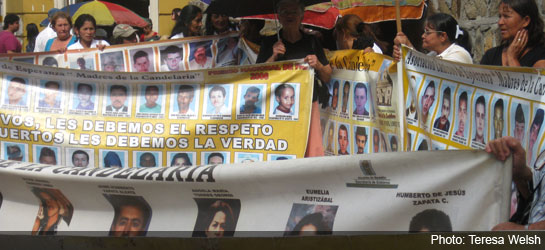
The number of “disappeared” in Colombia may be far higher than the official figure of 51,000, according to a report from the Latin America Working Group Education Fund (LAWG) and the U.S. Office on Colombia.
Victims of disappearances include human rights defenders, trade unionists, Afro-Colombians, indigenous people, young men and girls in rural conflict zones, members of the LGBT (lesbian, gay, bisexual, transsexual) community, homeless people, and other groups identified as “undesirables,” according to the report.
The report blames the phenomenon on various groups, saying that “Colombia’s armed forces and police and all illegal armed groups have been responsible for disappearances.” It points out that as paramilitary activity increased in the 1990s, so did disappearances attributed to the paramilitaries.
LAWG cites the “false positives” scandal as a cause of many disappearances in the past decade. The United Nation’s Special Rapporteur on Extrajudicial Executions, Philip Alston, found that soldiers had committed these killings “in a pattern that was repeated around the country.” In a false positive killing a military, or in some cases guerrilla, “recruiter” lured the victim to a remote location where they were then killed by the military and reported as a combat death. “Within the military,” says Alston, “success was associated with ‘kill counts’ of guerrillas.” By 2010 there were more than 3,000 cases registered in Colombian courts against the military in relation to false positives.
In 2007 the National Registry of the Disappeared was launched. The registry is an effort to create one unified database of missing people and unidentified bodies that will facilitate investigations. According to LAWG, though, “The Attorney General’s office … estimates that in hard-hit areas some 60 to 65% of disappearances go unreported.”
The report tells the story of Alejandra Rodriguez. When she was only a month old her father disappeared while he was working in the Palace of Justice‘s cafeteria during the M-19 guerrilla attack in 1985. “In the army’s no-holds barred retaking of the Palace, more than 100 people were killed, including 11 of the 24 Supreme Court justices. Twelve people, including eight people who worked in the court’s cafeteria, three visitors and a guerrilla were seen by witnesses being taken alive from the palace by the army. However, Alejandra says the government has always denied that any people were disappeared and it has been a constant struggle to get any information.”
“Every time the government denies that people were disappeared from the Palace of Justice, it’s like they are disappearing our loved ones all over again,” says Alejandra.
Lisa Haugaard, executive director of LAWG says, “The Colombian government’s recent efforts to search for the disappeared, and to conduct exhumations and return remains to victims’ families, are commendable, as are U.S. efforts to support this. But far more must be done to achieve justice in these cases, as well to expand the search for the disappeared, and most important, to end the practice of disappearing.”
The report gives a number of suggestions to Colombia and the U.S. governments for ways to bring justice to victims and stamp out the practice, but LAWG’s main conclusion is that it is important to spread information about disappearances. “For too long,” the report concludes, “the relatives of the disappeared and the few associations and human rights groups that accompany them have labored without adequate acknowledgment and support. It is long past time to help them break the silence.”
Read a Colombia Reports report on the struggle of victims’ families here.

